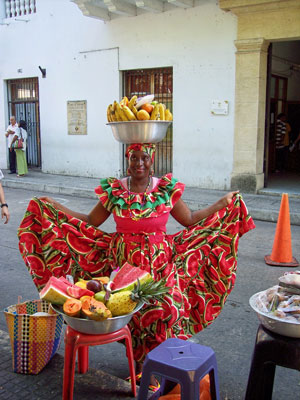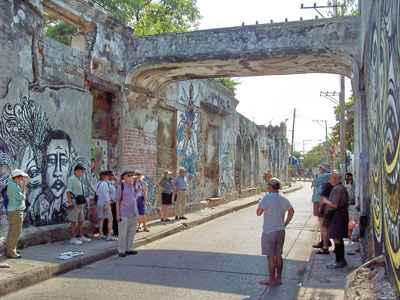Electric Cartagena
(3 of 3 on Colombia)
There is a frenetic energy that permeates Cartagena, captivating both locals and the throngs of visitors to Colombia’s popular Caribbean port city. Cartagena was the focus of the final portion of the spring 2013 tour “Colombia’s Colonial Jewels & The Coffee Triangle,” on which I was hosted by Overseas Adventure Travel.
The city of 1.5 million is, today, a magnet for visitors, and the economic impact of tourism clearly drives the local economy.
Our Cartagena itinerary was designed to provide a broad spectrum of experiences, including significant interaction with local residents in a variety of settings. We were encouraged by our Colombian tour leader, Marcela, to engage locals in conversation at every opportunity, and most of us eagerly complied.
From its founding in 1533, the time line of Cartagena reads like a swashbuckling movie script of Caribbean intrigue, replete with pirates, slave traders and the best-located port in the West Indies region for shipping products (including gold) from the new continent to Europe.
The strategic importance of the city also insured that it would be a target of pirates and corsairs, which is why it was walled and adjoined by the largest military structure in the Spanish colonies: Castillo San Felipe de Barajas.
With its 12-foot-high stone walls, Cartagena’s historic center is considered to be one of the best-preserved walled cities in the world. In 1984, UNESCO listed the castle fortress along with the walled city as a World Heritage Site.
Cartagena on the prowl
The itinerary on our first day and evening in Cartagena included a cumbia dance lesson and a wild ride through the city in a chiva (converted open-air truck with bench seats) with a trio of musicians aboard. We were able to quickly get in sync with the pulse of Cartagena, and most of us happily embraced the change to the warm weather of the Caribbean coast.
In the following two days, we toured the city on foot, visited chic Bocagrande, known for its sophisticated ambiance of shops, restaurants and beaches, and learned all about Colombia’s famous green gemstones and their production at an emerald workshop.
While some in our group mulled over purchases of pricey emeralds in the workshop showroom, I escaped into the street in search of a cortado (espresso with a dollop of cream).
Our second evening, we split into groups of four and each joined a local family for a home-hosted dinner. My group’s experience was rather basic but fully authentic and enjoyable.
Heat on the hoof
During the heat of the day, we paced ourselves for a walking tour of the historic San Felipe Castle fortress and an uneventful visit to the hilltop La Popa Convent, which honors La Virgen de la Candelaria, Cartagena’s patron saint.
We all enjoyed a walking tour of Getsemani, a lower-economic-strata neighborhood and the oldest part of the city.
The exterior walls of many buildings were decorated with large, colorful murals painted by local street artists, who seemed to fully exercise artistic license.
During our meandering walk, we were spontaneously invited inside a home for a tour by a lady who has relatives in southern Florida. To no one’s surprise, we learned that she rents out rooms in her home, which is set up rather like a hostel. Generally, we felt safe and welcome everywhere we traversed on foot.
When the sun goes down
On our final evening we toured the walled city in horse-drawn carriages. It was probably the only time in Colombia that I actually felt like a tourist, but it was, admittedly, good fun.
Every evening, both locals and visitors stroll through the lively streets of the historic center simply enjoying “the scene.” It is as though, in that moment, both know it is a great place to be and feel grateful for their good fortune.
In our brief, 3-day visit, we had time only to sample a small part of what Cartagena has on offer for visitors. I yearned for time on the nearby offshore islands and also to wander farther afield to explore small hamlets and villages along Colombia’s Caribbean coast. There is never enough time for vagabond types.
Our accommodation, the small, intimate Bantu Hotel, was strategically located in the middle of all the action in the historic center of the walled city. A pool would definitely have been nice — but not at the expense of the Bantu’s charm and ultraconvenient location.
Cartagena cocktail
My assessment is that Cartagena today is, in bartending terms, composed of the following: one shot colonial heritage, one shot slavery heritage, one shot bustling tourist activity, one shot New Orleans mystique and one shot tropical Caribbean coast ambiance, all thoroughly shaken, then infused with three shots of intoxicating Colombian music and dance. This mix has proven to be an appealing elixir for most visitors, as indicated by the large numbers of repeat travelers to the city.
Before you go…
The land cost of our 12-day/11-night Colombia tour is $3,095- $3,495 per person, double occupancy, with most meals included. Extensions for Ecuador and Bolivia are available with some departures.
For full details of this and a wide range of other small-group adventures (16 tour members, maximum) worldwide, contact Overseas Adventure Travel (One Mifflin Place, Ste. 400, Cambridge, MA 02138; 800/955-1925).
Keck's Beyond the Garden Wall
"If these walls could speak,
the tales they would tell,
the lore they would share
The best of times, the worst of times
Bold acts of human spirit
Humanity reproached
Epitaph survives purpose now
as celebration of survival,
and there’s a party going on"
— Randy contemplating the full life and times of Cartagena’s colonial-era city walls


